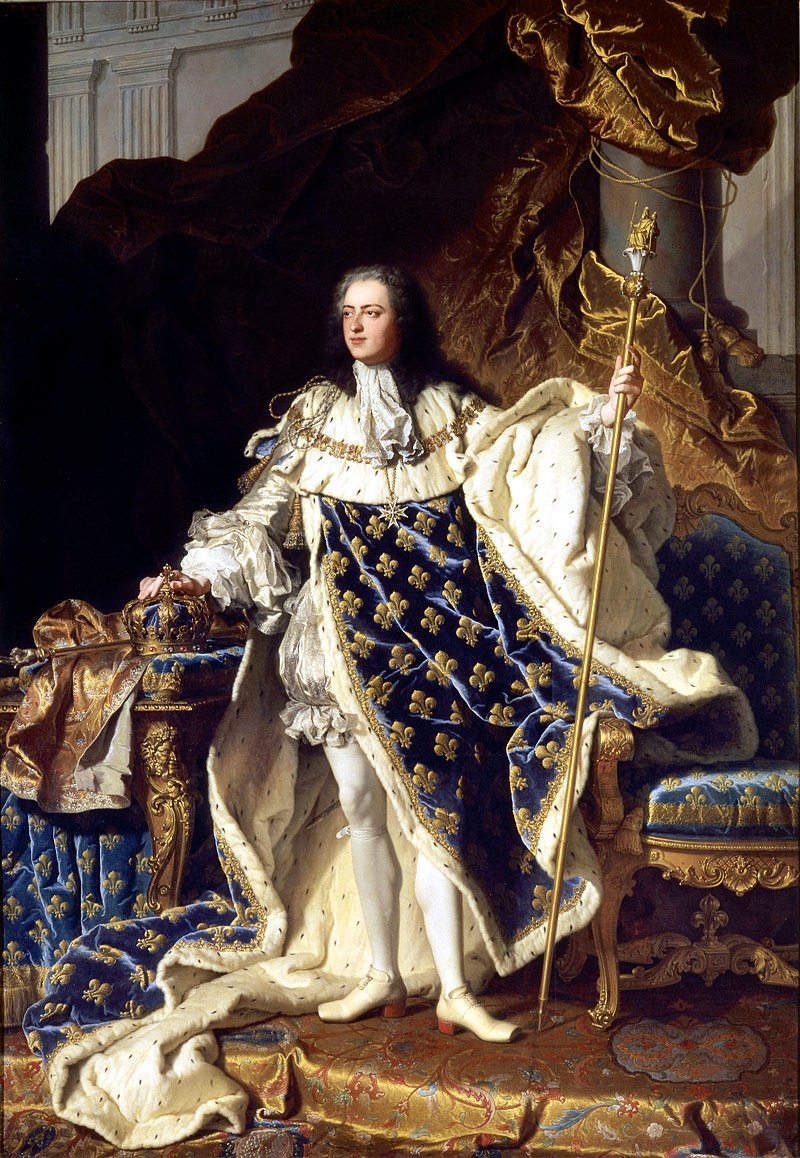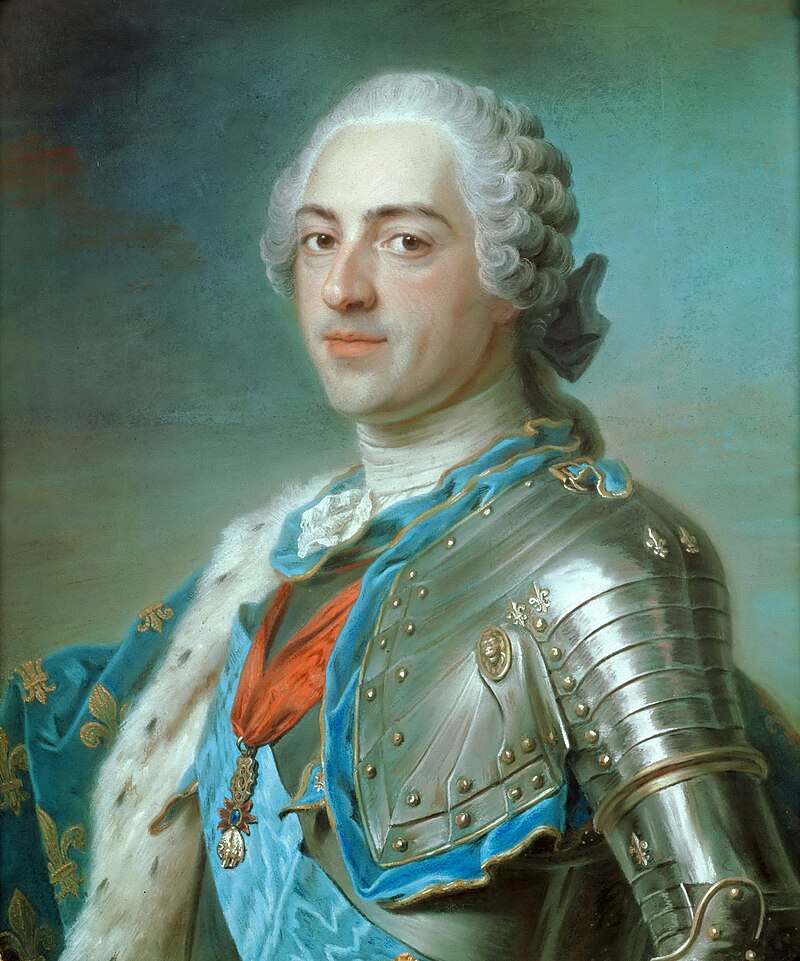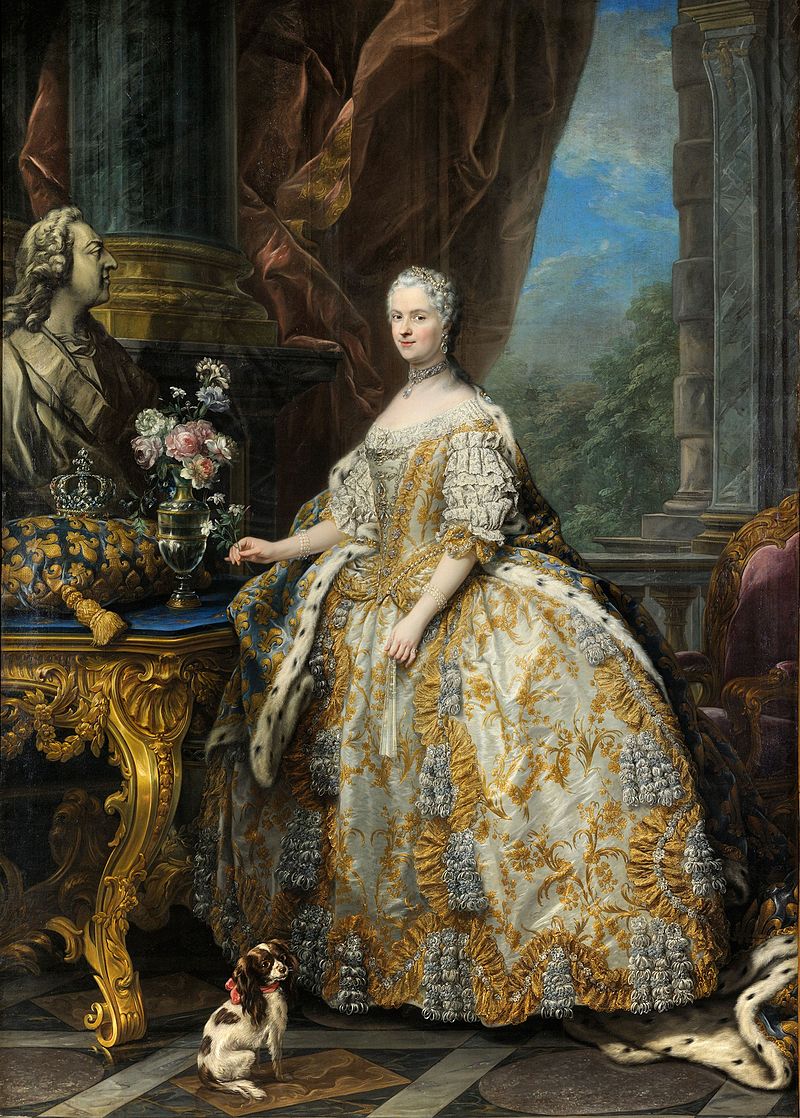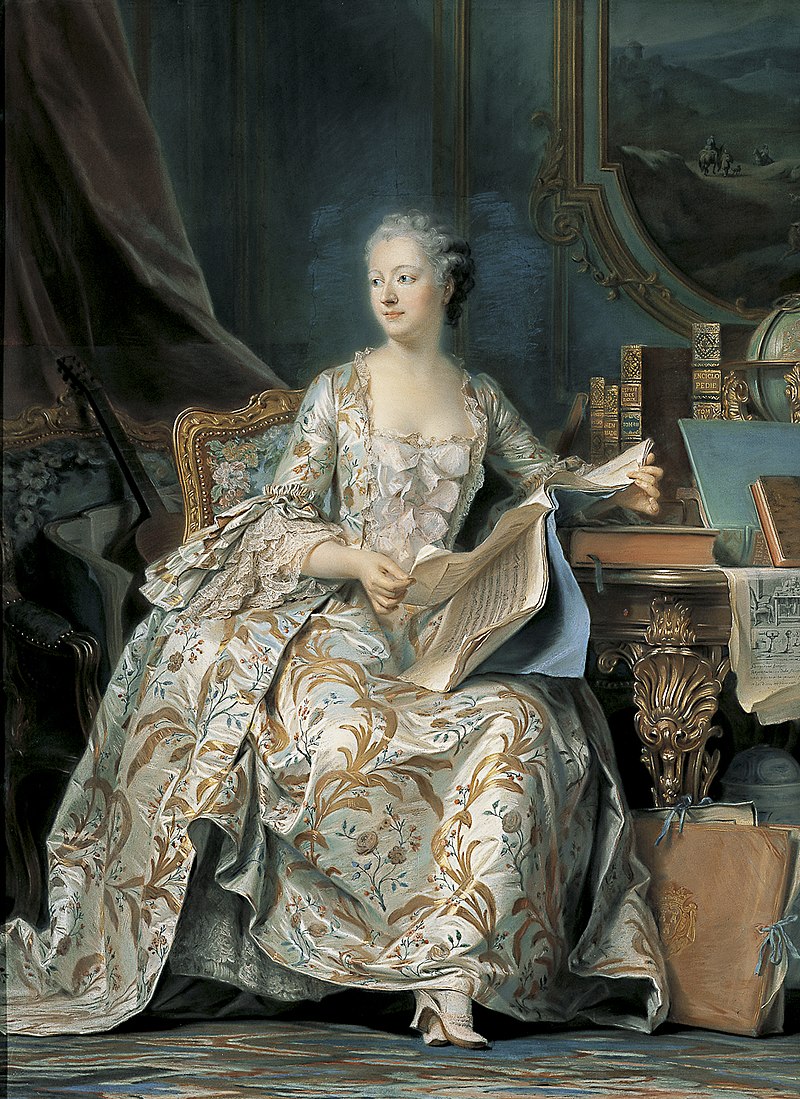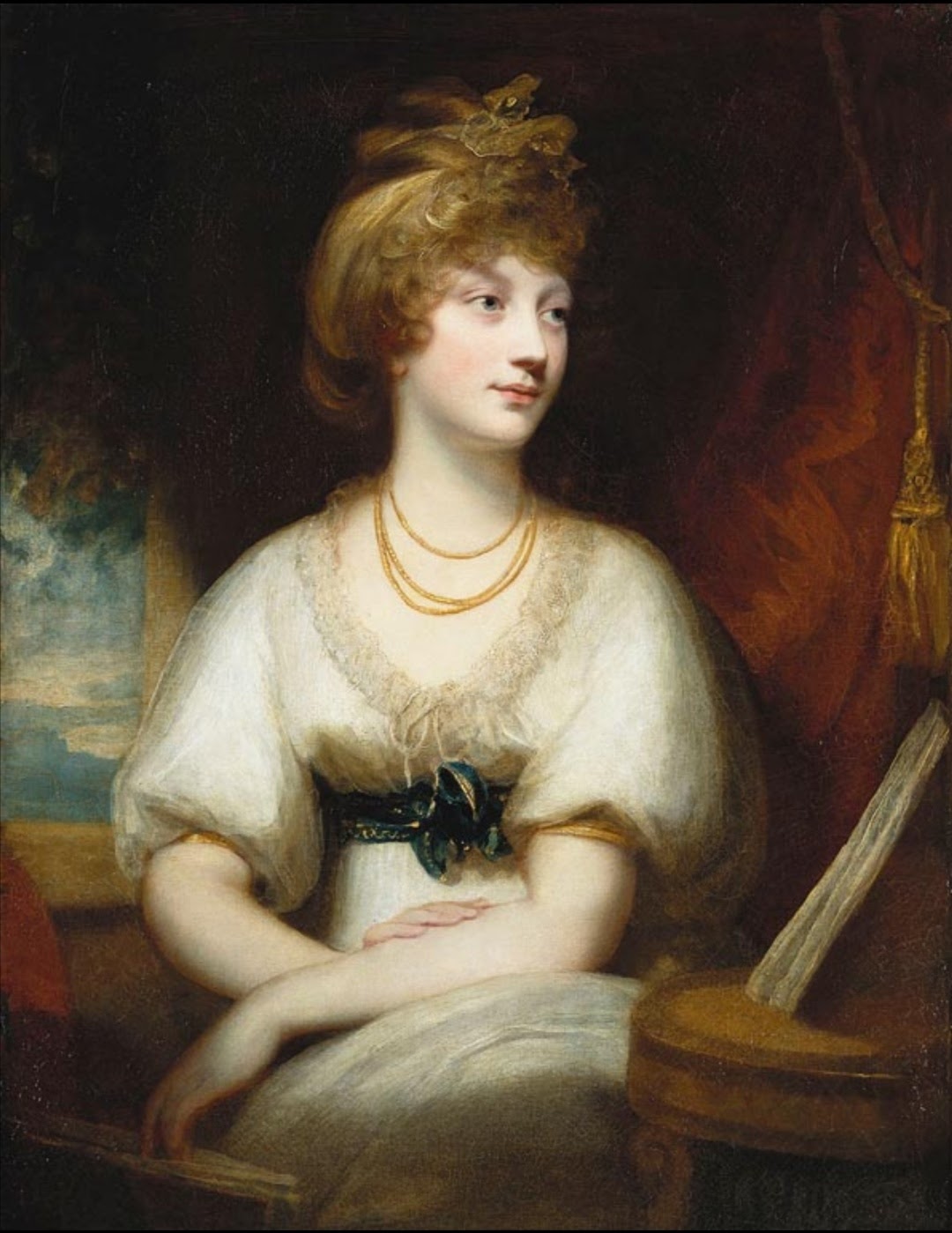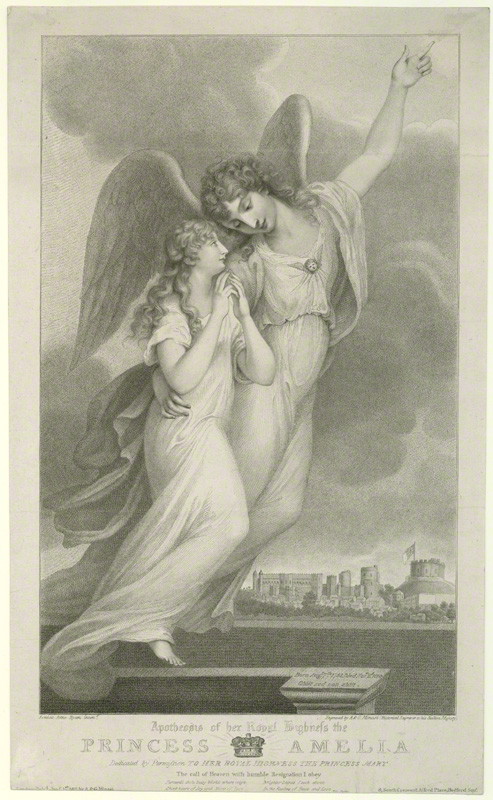by Susan Flantzer © Unofficial Royalty 2016

Princess Sophia of the United Kingdom; Credit – Wikipedia
Known for giving birth to an illegitimate son, Princess Sophia of the United Kingdom was the fifth daughter and the twelfth of the fifteen children of King George III of the United Kingdom and Charlotte of Mecklenburg-Strelitz. She was born at the Queen’s House (now Buckingham Palace) in London, England on November 3, 1777. Sophia’s mother wrote to her brother Karl about the birth, “I was taken ill and delivered in the space of fifteen minutes.”
On December 1, 1777, she was christened Sophia Matilda in the Great Council Chamber at St. James’ Palace by Frederick Cornwallis, Archbishop of Canterbury.
Her godparents were:

Sophia at age 5 by Thomas Gainsborough; Credit – Wikipedia
Sophia had fourteen siblings:
- King George IV of the United Kingdom (1762 – 1830), married Caroline of Brunswick-Wolfenbüttel, had issue: Princess Charlotte of Wales, who died in childbirth, as did her child
- Prince Frederick, Duke of York (1763 – 1827), married Frederica of Prussia, no issue
- King William IV of the United Kingdom (1765 – 1837), married Adelaide of Saxe-Meiningen, no surviving legitimate issue, has illegitimate descendants
- Charlotte, Princess Royal (1766 – 1828), married King Friedrich I of Württemberg, no surviving issue
- Prince Edward, Duke of Kent (1767 – 1820), married Victoria of Saxe-Coburg-Saalfeld, had issue: Queen Victoria, the present British Royal Family are his descendants
- Princess Augusta Sophia (1768 – 1840), never married, no issue
- Princess Elizabeth (1770 – 1840), married Friedrich, Landgrave of Hesse-Homburg, no issue
- King Ernest Augustus I of Hanover, Duke of Cumberland (1771 – 1851), married Friederike of Mecklenburg-Strelitz; had issue
- Prince Augustus Frederick, Duke of Sussex (1773 – 1843), married twice, both in contravention of the Royal Marriages Act of 1772 (1) Lady Augusta Murray, had issue, marriage annulled (2) Lady Cecilia Buggin (later 1st Duchess of Inverness), no issue
- Prince Adolphus, Duke of Cambridge (1774 – 1850), married Augusta of Hesse-Kassel, had issue, the present British Royal Family are his descendants through his granddaughter Mary of Teck, who married King George V of the United Kingdom
- Princess Mary (1776 – 1857), married Prince William Frederick, Duke of Gloucester, no issue
- Prince Octavius (1779 – 1783), died in childhood
- Prince Alfred (1780 – 1782), died in childhood
- Princess Amelia (1783 – 1810), never married, no issue

Queen Charlotte painted by Benjamin West in 1779 with her 13 eldest children; Credit – http://www.royalcollection.org.uk
The three younger sisters, Mary, Sophia, and Amelia, were educated together, spending much time with Charlotte de Montmollin, their new French governess, who taught the sisters French and needlework. Jane Gomm joined the sisters in 1786 as an English teacher and supervised the rest of their education. Mary, Sophia, and Amelia lived much of the time apart from their parents, sometimes with the younger brothers at Kew Palace, but most often at Lower Lodge (now called Royal Lodge) at Windsor. The three younger sisters were much less disciplined than the three elder sisters. The artist John Singleton Copley discovered this when he painted Sophia, Mary, and Amelia with the family pets in 1785. The children, the dogs, and the parrots would not cooperate. Somehow, Copley managed to finish the painting, but he then returned to historical painting and never painted another portrait. The Copley painting is below.

Left to right: Sophia, Amelia, and Mary, The Three Youngest Daughters of King George III by John Singleton Copley, 1785; Credit – Wikipedia
Sophia was the favorite of many of her tutors and attendants and considered the cleverest of the sisters. As a child, she showed amazing sympathy for the less fortunate. She listened carefully when her father read newspaper articles aloud at the breakfast table. One day, when she had been told about prisons and the situation of prisoners, she offered to give all her allowance to buy bread for the prisoners. Her parents were so touched that they agreed to contribute additional money.
Sophia’s childhood was very sheltered, and she spent most of her time with her parents and sisters. The living conditions of King George’s daughters came to be known as “the Nunnery.” None of the daughters was allowed to marry at the age when most princesses would marry. Perhaps this over-protection of King George III’s daughters was due to what happened to his sister Caroline Matilda when she married King Christian VII of Denmark. Christian’s mental illness led to Caroline Matilda having an affair, being caught, the execution of her lover, her exile, and her early death from scarlet fever at age 23. The story was told in several novels, including Per Olov Enquist’s The Visit of the Royal Physician (1999) and the Danish film A Royal Affair (2012). Stella Tillyard also covers Caroline Matilda’s affair in her nonfiction book A Royal Affair: George III and His Scandalous Siblings (2006). Despite what happened to their aunt, the sisters longed to escape from “the Nunnery.”
Before King George’s first bout with what may have been porphyria was in 1788, he had told his daughters that he would take them to Hanover to find husbands. Further bouts occurred in 1801 and 1804 and prevented talk of marriage for his daughters. Queen Charlotte feared that the subject of marriage, which had always bothered her husband, would push him back into insanity. She was stressed by her husband’s illness and wanted her daughters to remain close to her. The sisters – Charlotte, Augusta, Elizabeth, Mary, Sophia, and Amelia – continued to be over-protected and isolated, restricting them from meeting eligible suitors.
In December 1800, Sophia wrote a rather cryptic letter to Elizabeth Harcourt, wife of George Harcourt, 2nd Earl Harcourt, who was one of her mother’s ladies of the bedchamber: “…the excessive kindness of your manner has, I assure you, greatly soothed my distressed and unhappy days & hours…It is grievous to think what a little trifle will slur a young woman’s character forever. I do not complain, I submit patiently, & promise to strive to regain mine, which, however imprudent I have been, has I assure you been injured unjustly.” It seems that this referred to Sophia’s affair with Major-General Thomas Garth.
With limited exposure to eligible men, Sophia and several sisters became involved with courtiers and equerries. Major-General Thomas Garth, an equerry to King George III, was 56 years old, 33 years older than Sophia, and had a large purple birthmark that disfigured his face. Sophia and Garth were allegedly lovers during the winter of 1799 at Windsor Castle, resulting in a pregnancy. In the summer of 1800, Sophia went to the seaside town of Weymouth, a holiday destination for the royal family, pretending to be suffering from dropsy.
Apparently, on August 5, 1800, Sophia gave birth to a son in Weymouth who was christened at the parish church on August 11, 1800. He is listed in the parish register as “Thomas Ward, stranger,” stranger meaning foundling, and adopted by Samuel and Charlotte Sharland. Samuel Sharland was a local tailor and a colonel in the Weymouth Volunteers. Eventually, Major-General Garth adopted the boy, renamed him Thomas Garth (Tommy), paid for his education at Harrow School, made him his heir, and helped him in an army career in the 15th The King’s Hussars, his old regiment. Later, defamatory rumors circulated that the child’s father was Sophia’s brother, Prince Ernest, Duke of Cumberland. Legend has it that when King George III noticed that Sophia was gaining weight, he was told it was caused by eating roast beef and was later cured by sea-bathing.

Painting of Sophia commissioned by The Prince of Wales by Sir William Beechey, 1797; Credit – Wikipedia
Sophia’s eldest sister, Charlotte, Princess Royal, had married at age 31, the earliest age of the three sisters who married. George, Prince of Wales (future King George IV) felt sympathetic to the plight of his sisters in “the Nunnery.” Sophia lived with her mother until she died in 1818. George’s efforts to help his sisters led to the marriages of Mary and Elizabeth. After Queen Charlotte died in 1818, George allowed Augusta and Sophia their domestic freedom, although it was too late for them to marry. From her mother, Sophia inherited Lower Lodge at Windsor Great Park, which she gave to her brother George. After her mother died, Sophia lived at Kensington Palace, next to her niece, Princess Victoria of Kent, the future Queen Victoria. As a result, Sophia was one of the few paternal relatives that Victoria often saw.
In the early 1830s, Sophia’s eyesight began to cause her problems. By 1832, she had lost sight in her right eye. However, Sophia remained in good spirits and continued to ride and play music. On June 20, 1837, Sophia’s brother King William IV died, and her niece Victoria became Queen. Sophia wrote to Victoria, “My dear Victoria, The awful day is arrived which calls you to fill the most exalted and important station in our country.” Sophia had to move from Kensington Palace as that part of the palace needed to be renovated. Her new home was York Place in Vicarage House, adjacent to Kensington Palace. Unfortunately, the sight in her good eye, the left one, was also diminishing. By December of 1837, Sophia’s eyesight had completely failed. By 1838, she could only see light when she was outdoors. Her friend Frances, Baroness Bunsen described Sophia as “never complaining, always cheerful, talking of the many blessings she had to be thankful for.”
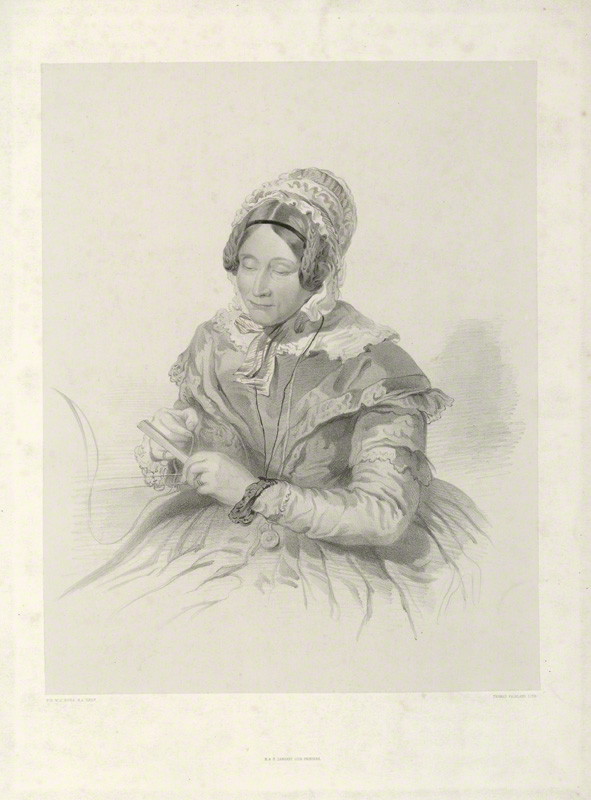
Princess Sophia by Thomas Fairland, after Sir William Charles Ross, lithograph, circa 1840s, NPG D33323 © National Portrait Gallery, London
After Victoria became Queen and moved to Buckingham Palace, Sophia and Victoria continued to correspond. In January 1846, Queen Victoria and her five-year-old daughter, Victoria, Princess Royal, paid a luncheon visit to Sophia. Queen Victoria noted in her diary that they found, “a sad sufferer and a complete cripple, unable to move, and quite blind. In spite of it all, she is quite cheerful. She was much pleased at my bringing Vicky who was civil and good.” In January 1848, Sophia’s brother Adolphus, Duke of Cambridge reported to Queen Victoria that Sophia was “in a precarious state and, I fear, sinking…she seems herself not to wish to live on.” On February 14, 1848, Queen Victoria visited Sophia and found her “much altered. She is nearly bent double, and very much wasted, and her voice is very feeble.”
On the morning of May 27, 1848, Sophia’s family was warned that the end was near. She was visited by her sister Mary, her sister-in-law Queen Adelaide, and her nephew-in-law Prince Albert. She died later that evening at the age of 70, with her sister Mary and her sisters-in-law, the Duchess of Kent and the Duchess of Cambridge, present. Two days after her death, Sophia’s banker brought a letter to Queen Victoria in which Sophia stated she wished to be buried in Kensal Green Cemetery in Kensal Green, London close to where her brother Prince Augustus, Duke of Sussex had been buried, and that she wished her funeral to be as private as possible. Her funeral was private, and she was temporarily laid to rest in the cemetery’s vault while a tomb was built. A year later, Sophia’s remains were transferred to the tomb.
This article is the intellectual property of Unofficial Royalty and is NOT TO BE COPIED, EDITED, OR POSTED IN ANY FORM ON ANOTHER WEBSITE under any circumstances. It is permissible to use a link that directs to Unofficial Royalty.
Works Cited
Fraser, Flora. Princesses: The Six Daughters of George III. New York: Alfred A. Knopf, 2004. Print.
“Princess Sophia of the United Kingdom.” Wikipedia. N.p.: Wikimedia Foundation, 17 July 2016. Web. 18 Aug. 2016.
Van Der Kiste, John. The Georgian Princesses. Phoenix Mill: Sutton Publishing, 2000. Print.
Williamson, David. Brewer’s British Royalty. London: Cassell, 1996. Print.



